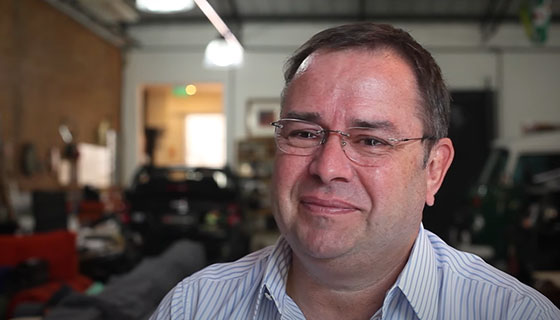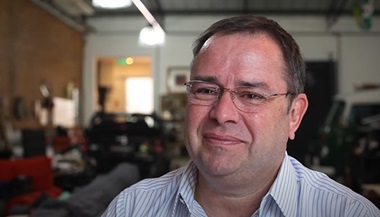Patient Story
Kidney Cancer: Sue's Story
Kidney Cancer | Sue's Story
Patient Story Highlights
- Human resources executive Sue was shocked to find her pain, weakness and broken bones were the result of cancer that had spread from her kidney. The complexity of her situation led her to Johns Hopkins.
- After removal of cancer metastases from her spine followed by radiation, Sue had surgery to remove her left kidney, and treatment with immunotherapy and targeted therapy.
- In February 2022, Sue got the news that she had a complete response from her treatment and is now resuming her active life.

Sue before her kidney cancer diagnosis
“I have no interest in retiring,” says Sue DiSilvestre, who turned 70 in February 2024 and works from home as human resources director at a Washington, D.C., government contract agency. Sue still finds time to travel with her husband Ray and keep up with her teen grandchildren, who live with the couple in Anne Arundel County, Maryland.
But in December 2020, she was facing a serious threat to her health. A scan of what Sue assumed was pain and weakness from a knee replacement revealed renal cell carcinoma ― the most common type of kidney cancer ― which had metastasized (spread) to Sue’s spine. The tumor in the spine was pressing on her spinal cord and the nerves controlling her legs.
To complicate matters, Sue has von Willebrand disease, which affects her blood’s ability to clot. Given the complexity of Sue’s situation, her local hospital recommended care at a comprehensive cancer center. Sue chose The Johns Hopkins Hospital.
She’s glad she did. Recalling her care, Sue says, “It was worth the 1½- to 2-hour drive. I encountered not one unpleasant person in the entire hospital. Not one. No one said, ‘I’ll come back’ and then didn’t show. They give 100% to their patients.”
Assembling the Kidney Cancer Team
Addressing this advanced cancer required a fast, coordinated effort. Yasser Ged, M.B.B.S., a medical oncologist specializing in kidney cancer, assembled all the specialists Sue would need. “Sue had multiple teams coordinated in her care, with specialists in the particulars of kidney cancer to help coordinate and work with urology and neurosurgery.”
Here was the plan: Hematologists, doctors who treat blood diseases, ordered special medication to address the von Willebrand disease. Ali Bydon, M.D., professor of neurosurgery and expert on surgical spinal oncology, would remove the metastatic cancer from Sue’s spine. Sue would then receive highly targeted treatments with radiation oncologist Kristin Redmond, M.D., M.P.H., who specializes in tumors of the central nervous system. Removing her left kidney, where the cancer was originating, would be the next step, performed by urologic oncologist Nirmish Singla, M.D.
“I call Dr. Ged the leader of the band. He is so modest, so down to earth,” Sue says. “The whole group knows each other. They worked together, coordinated, so I got the best treatment.”
Removing Spine Metastasis
The doctors knew they had to work quickly to address the cancer, which was in two places: Sue’s left kidney and spine. Without the surgery, Bydon knew his patient could become paralyzed within days. Sue says facing the spine surgery was frightening.
She says, “There were so many risks. I knew I had a good doctor; Bydon was the best, and Singla and Ged agreed. But I felt vulnerable knowing they were going to open the spine and hoped I’d be pain-free and able to walk. When you only have 24 hours to decide, everything hits you at once, but I understood there was a small window of time.”
The spine procedure was daunting. A network of blood vessels had formed, feeding the aggressive tumor. The six-hour operation was fraught with risks including significant blood loss, which Bydon points out is especially hazardous in someone over age 60.
Bydon explains, “Before surgery we injected a special blood vessel glue, endovascularly through her groin to reduce blood flow to the tumor to about 50%.”
Stopping the blood flow entirely could deprive the spinal cord of oxygen and cause a spinal cord stroke. But slowing it down by partially blocking the blood supply gave Bydon and his team time to remove one of Sue’s vertebrae (spine bones) and as much cancer as possible, then rebuild the spine with hardware so Sue could stand and walk ― all while keeping up with replenishing her blood loss.
Bydon also knew that for the radiation to be effective, Redmond needed to treat the area with high-dose radiosurgery (targeted radiation), since kidney cancer is relatively resistant to radiation therapy. Redmond has unique expertise in delivering this specialized form of radiation therapy and has written the guidelines that drive care in this setting. “Everyone worked with the next stage in mind. I needed to decompress more of the nerves so the radiation can be given at a higher dose,” Bydon says.
Together, Bydon and his team beat the odds. “Slowing the blood flow gave us time to reconstruct the [second lumbar] vertebra and decompress the severely compressed and compromised nerve roots,” he says. Sue ended up needing six units of blood, but the surgery prevented paralysis, preserved her urinary continence and restored her ability to walk without pain.
“We made an almost impossible operation possible,” Bydon says.
Sue returned home on Christmas Day 2020, and had radiosurgery on her spine in January 2021. The first hurdle was cleared.
Kidney Cancer Surgery
Next, in February, came surgery to remove Sue’s left kidney. Singla notes that although the cancer was advanced when he treated, it was not yet widespread. Patients with cancers that are oligometastatic (with limited areas of spread) may be good candidates for surgery.
Dr. Singla used a robotic technique he regards as a next-generation minimally invasive procedure. “Sue’s surgery went very well. It involved a few small incisions and then one just large enough to remove the kidney,” he says. “There were no complications. Sue stayed in the hospital two days, a little longer than usual to monitor her blood coagulation.”
Singla says good surgical outcomes are a byproduct of the coordinated approach. “We have a great team,” he says. “The entire genitourinary oncology group meets weekly and works together very well. Together we discuss what to do, and when, and vet questions as a group.”
The cancer returns
In September 2021, Sue and Ray were back into their routine and vacationing in Florida. However, as she attempted to ease into an inner tube while relaxing in the pool, Sue heard a sickening snap.
The cancer was back. It had invaded the bone in her arm and weakened it to the point where it fractured from this simple motion. Sue’s vacation ―and her peace of mind ― were put on hold.
A Bold Approach to Kidney Cancer Medicine: Targeted Immunotherapy
Sue went back to Ged, who says that new scans revealed the cancer had invaded not only Sue’s arm bone, but also her chest and pericardium, the membrane surrounding the heart. “The situation was very serious,” Ged says.
Ged coordinated with experts in oncologic bone disease, and Sue had surgery to repair the broken arm and more radiotherapy on that area. But Ged also wanted to act quickly and start the next attack on the increasingly aggressive cancer. The next weapon would be a combination of immunotherapy and targeted therapy.
The general recommendations are to wait for about three to four weeks before starting treatment to avoid wound healing complications, but Sue healed quickly, and Ged recommended starting treatment one week after the arm surgery given the severity of the situation.
Immunotherapy turns the body’s own immune system against cancer cells to destroy them. Targeted therapy homes in on the processes that allow cancer cells to grow, multiply and spread to other areas of the body. Drugs called immune checkpoint inhibitors combine these two principles.
Kidney cancer has been shown to respond to this powerful combination approach, and Ged and his team knew it could give Sue a chance. But the results surprised them all.
Treating Kidney Cancer with Immune Checkpoint Inhibitors
Ged’s published research on renal cell carcinoma treatment shows how combinations of immune checkpoint inhibitors are changing kidney cancer treatment and the outlook for patients.
“The first thing I did was call her….”
After a few months on the medicine combo, Sue went in for a scan. The radiologist called Ged with the results: The metastases in Sue’s chest and pericardium had disappeared, and he could not find any evidence of cancer.
“I looked at the scans myself, and was surprised and extremely delighted,” recalls Ged. “The first thing I did was call [Sue].”
“I was in shock,” Sue says. “I got the call from Dr. Ged with my test results, and I thought it was a mistake. My husband and I were speechless. It was a miracle.”
Sue completed her two-year regimen with the drugs late in 2023. She has some nausea on occasion, but for the most part, the side effects of the drug regimen have been tolerable.
“I have good days and bad,” she says. “I had no clue as to how this would end up. But I think of what could have happened and it’s overwhelming. I want to live every day to the fullest. I’m still trucking, and it’s possible that I may not die of this cancer.”
Ged says that the therapy and its outcomes are still being revealed, but that with every clear scan, confidence builds. “For stage 4 kidney cancer like this, we have to be realistic but also hopeful, and use our expertise to guide our patients step by step, decision by decision.
“Kidney cancer therapy has advanced with research and the picture is different from even five years ago,” he says. “There’s more to come: We’re building on the enormous amount that we’re learning and assembling a large portfolio of new kidney cancer clinical trials to offer to our patients cutting-edge technologies and treatments.”
Singla concurs, adding, “Compared to the landscape just 10 years ago, the complete response rates we’re seeing are testaments to how far we’ve come. With a coordinated approach, we’re seeing better survival with tolerable side effects. For the surgical part of the treatment, minimally invasive robotic approaches are letting patients go home in a day or two without needing narcotics. We try to spare kidney function where possible, but if we have to remove a kidney, as in [Sue’s] case, a patient can be OK with just one.
“A kidney cancer diagnosis is daunting, but now we have more tools than ever to fight it. This can be a survivable cancer.”
Sue's Care Team
-
Yasser Mohamed Ali Ged, M.B.B.S.

Primary Location: Skip Viragh Outpatient Cancer Center, Baltimore, MD
-
Nirmish Singla, M.D., M.Sc.

Primary Location: The Johns Hopkins Hospital (Main Entrance), Baltimore, MD
-
Kristin Janson Redmond, M.D., M.P.H.

Primary Location: Johns Hopkins Sidney Kimmel Comprehensive Cancer Center, Baltimore, MD






